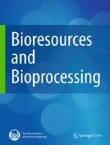Bioresources and Bioprocessing is associated with the State Key Laboratory of Bioreactor Engineering, East China University of Science and Technology.
Exotic glycerol dehydrogenase expressing Escherichia coli increases yield of 2,3-butanediol
The thriving of biodiesel industry has led to produce 10% (v/v) crude glycerol, thus creating an overflow problem. Biofuel production is restricted by Escherichia coli due to its toxicity to bacterial cells. Ther...























